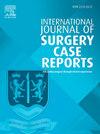Carotid body tumor associated with complete heart block: A rare case report with long-term follow-up
IF 0.6
Q4 SURGERY
引用次数: 0
Abstract
Introduction
Carotid body tumor (CBT) is one of the most common paragangliomas in the head and neck region, accounting for only 0.6 % of tumors in this area. Here, we present a rare case of CBT associated with congenital complete heart block (CHB).
Case presentation
We report the case of a 47-year-old female with a history of left neck and ear pain, accompanied by a gradually enlarging neck mass over 2.5 years. Following initial evaluations and multiple differential diagnoses, CT angiography revealed an oval-shaped mass measuring 30 × 50 mm at the left carotid bifurcation, confirming a Shamblin type II CBT. Preoperative assessments demonstrated congenital CHB on electrocardiogram and echocardiography. The patient underwent complete tumor resection with all necessary precautions, including temporary pacemaker placement and careful monitoring.
Clinical discussion
CBTs are considered rare neoplasms, comprising only 0.6 % of head and neck tumors and approximately 0.03 % of all neoplasms. The surgical outcomes demonstrated that despite the coexistence of a CBT with CHB, safe and successful surgery is possible with careful planning and comprehensive management.
Conclusion
This case highlights the importance of precise diagnosis and management in rare combination cases and emphasizes the crucial role of collaboration between vascular surgery and anesthesiology specialists in minimizing surgical risks and improving patient quality of life.
求助全文
约1分钟内获得全文
求助全文
来源期刊
CiteScore
1.10
自引率
0.00%
发文量
1116
审稿时长
46 days

 求助内容:
求助内容: 应助结果提醒方式:
应助结果提醒方式:


